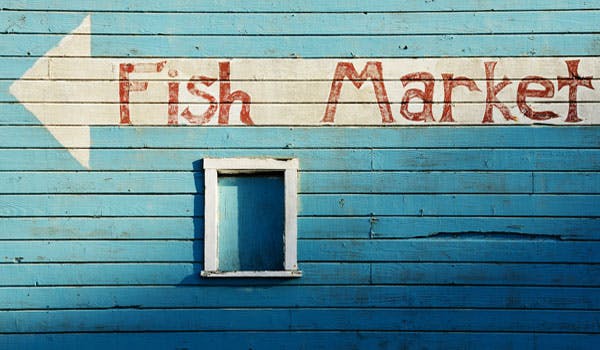Last week I spent two mornings at the Sydney Fish Market.
Up before dawn for the first time in…. well, a long time – I headed along for a media familiarisation with the market, and had the pleasure of meeting an array of salty characters.
For the uninitiated, each and every morning since 1945, the Sydney Fish Market in inner-city Pyrmont, has been home to the biggest daily seafood auction in the southern hemisphere.
The market has changed a lot over the years, and far from hosting a burly crowd of fishmongers haggling for a bargain, punters engage in a highly refined auction process.
A grandstand of high-vis wearing buyers sit before the auction floor, where with just a few keystrokes, hundreds of kilos of seafood can be purchased. Two large digital clocks are projected onto a screen as part of the Dutch auction system, and two auctioneers oversee the proceedings.
Gus Dannoun – the supply manager with over 30 years experience – talked me through the ins and outs of the market, the auction system, and how things have changed over the years. Wandering around for a meet-and-greet with some of the buyers and distributors, I found a chance-comment from veteran seafood buyer Allen, to be particularly poignant.
“Twenty years ago, it used to be a case of the customer asking in the shop ‘What have you got today?’ These days, it’s completely the opposite. The expectation is that the shop will have exactly the type of barramundi, or yellow-fin tuna or whatever it may, that they want.”
Allen wasn’t being critical of the modern-day seafood consumer. He was simply making an observation that buyers have needed to respond to this trend, and his purchasing style reflects this.
Undoubtedly, the Australian palate has become more sophisticated over time. Customers (think) they know what they want, and they go into a shop wanting to purchase a particular fish or crustacean that they know and like.
However, Allen’s comment also reminded me of an issue experienced by the wine industry.
A recent study of Australian grape diversity discovered that what we’re producing these days is not all that different to what’s found elsewhere in the world.
One key reason for this lies in the marketing of varieties to consumers. It seems the hard-to-pronounce factor, combined with not having heard of a particular grape varietal, sends consumers straight to the sauvignon blanc.
The same problem is true of seafood, and indeed many consumable products. To me, I see the burden of sustainable consumption, and safeguarding diversity, as a shared responsibility between business owners and consumers alike.
Whatever your product may be, is there scope to better educate your market about what you do, and what you’re selling? Hosting a workshop or a class, disseminating a pamphlet, starting a blog on your website, engaging with your fanbase on social media – there are so many possibilities. And as a bonus, you may win yourself some new and more loyal customers as a result.
Is it not up to all of us to be more educated about what we’re selling, and also what we’re buying? Where do we draw the line though? Tell me your thoughts at editorial@dynamicbusiness.com.au

